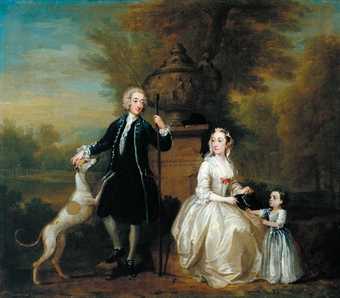The initial transfers made in 1919 remained the sole representation of Hogarth at the Tate until after the Second World War when further transfers were made.
In 1949 The Staymaker was transferred to Tate, but the following year Marriage A-la-Mode was returned to the National Gallery. This iconic series of paintings returned to Tate briefly in 1960–1 and 1963–4, but after that remained in Trafalgar Square where it can still be seen today.
In 1951 the second major transfer of works by Hogarth was made from the National Gallery to Tate, with five paintings moved over to Millbank: The Strode Family, James Quin, Mrs Salter, The Painter and his Pug, and O the Roast Beef of Old England (‘Calais Gate’). Hogarth’s large conversation piece, The Graham Children, was also transferred the following year.
As with the Curzon Report, these transfers coincided with the moment when the constitution of the national galleries was being considered, culminating in the National Gallery and Tate Gallery Act of 1954 in which the Tate became legally separated from the National Gallery as an independent institution. Further transfers from the National Gallery around that time made sure that the right pictures were in the right gallery, with more sixteenth and seventeenth-century pictures entering the Tate collection. This, combined with the acquisition of early British pictures in the 1950s meant that Hogarth would no longer form the starting point in the story of British art in the displays at Millbank.
The guide to the Tate Galley from 1951 shows that the first gallery now displays seventeenth- and early-eighteenth century pictures, with works by Cornelius Johnson (1593–1661), Sir Peter Lely (1618–1680), and Sir Godfrey Kneller (1646–1723) preceding those by Hogarth and his contemporaries, whilst in the entrance hall and staircase hung seventeenth and eighteenth-century portraits, as well as Tudor and early Stuart portraits lent by Mr Francis Howard and Group Captain Loel Guinness.
Two remaining works were transferred from the National Gallery in 1960: Heads of Six of Hogarth’s Servants and The Shrimp Girl. This was the same year that the Marriage A-la-Mode series returned to Tate, though only for a year. In the event, The Shrimp Girl went back to Trafalgar Square with it, making a brief return in 1963–4 before remaining there.
The final work to be transferred from the National Gallery was the portrait of Thomas Pellet M.D., sent to Millbank in 1972 having entered the collection of the National Gallery that year following a Deed of Gift made in 1959.
In 1964 Norman Reid succeeded John Rothenstein as Director of the Tate and organised a re-hang of the displays. Works by Hogarth were gathered into room 2, the small hexagonal room with the mosaic floor which is often referred to as the Blake room, forming a monographic representation of Hogarth there for many years.

William Hogarth
Ashley Cowper with his Wife and Daughter (1731)
Tate
The newly independent Tate Gallery acquired its first work by Hogarth in 1965. This was the conversation piece of Ashley Cowper with his Wife and Daughter, signed and dated 1731, which was bought at auction at Sotheby’s on 24 November 1964 by Agnew on behalf of Tate.
Another work entered Tate’s collection a few months later in the following year, Satan, Sin and Death, purchased from Sabin Galleries. Three further paintings have been purchased by Tate since then: Thomas Herring in 1975, having been lent to Tate from a private collection since 1968; The Dance in 1983, also having been lent since 1968 by the South London Gallery; and the oil sketch Head of a Lady, the last work bought by Tate in 1994.
To mark the centenary of Tate in 1997, the two small portraits of the Ranby children were presented as gifts to the gallery from a private collection, and in 2003 Three Ladies in a Grand Interior (‘The Broken Fan’), having been accepted by H.M. Government in lieu of tax, was allocated to Tate – the most recent work to enter Tate’s collection.
In 1984 the National Gallery requested the return of five important British pictures, which it argued were required for display in the context of Old Master European painting at Trafalgar Square. The list included An Experiment on a Bird in an Air Pump by Joseph Wright of Derby and the large conversation piece by Hogarth, The Graham Children, which had been at Tate since 1952.
The two institutions had formed an agreement in 1954 that the National Gallery had the right to claim any work that had entered either collection prior to 1954, though this was superseded by the 1954 Act which had created an independent Tate and made it clear that any transfers must be made by consultation and agreement.
But the Tate felt that the National Gallery had a moral claim on the pictures and did not want to jeopardise relations, so the works were eventually returned in 1987. As Francis Spalding notes in her history of the Tate Gallery,
there is no doubt that the loss of the Hogarth and the Wright, in particular, seriously impoverished the Tate’s representation of eighteenth-century art.
